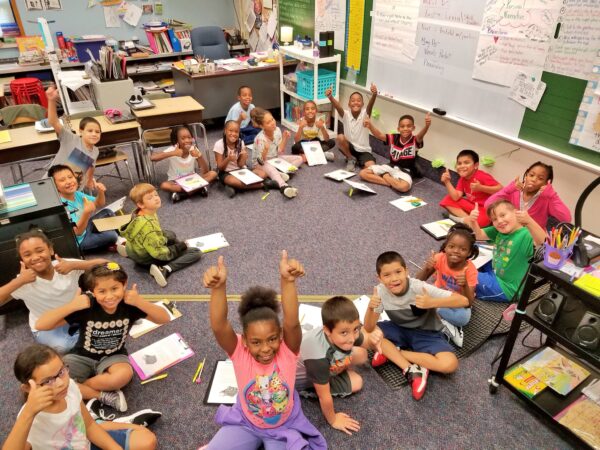تفاقم اضطراب تعاطي المخدرات (SUD) في جميع أنحاء الولايات المتحدة وداخل ولاية إنديانا في السنوات الأخيرة، خاصة خلال جائحة كوفيد-19. غالبًا ما يبدأ تعاطي المخدرات في سن مبكرة، وأولئك الذين يتعاطون المخدرات أو الكحول في سن المراهقة المبكرة هم أكثر عرضة للإصابة باضطراب تعاطي المخدرات.1 في الواقع، في العام الماضي، أبلغ 23% من طلاب السنة النهائية في المدارس الثانوية في ولاية إنديانا عن استخدام السجائر الإلكترونية، وأبلغ 6.7% عن استخدام السجائر في الشهر الماضي. أبلغ 28.5% من كبار السن في المدارس الثانوية في ولاية إنديانا عن تعاطي الكحول في الشهر الماضي.2 يمكن للمدارس أن تلعب دورًا حاسمًا في مكافحة SUD من خلال تنفيذ مبادرات التدخل المبكر.
في عام 2018، تم إطلاق مؤسسة ريتشارد إم فيربانكس مسائل الوقاية، وهي مبادرة منحة متعددة السنوات تهدف إلى مساعدة مدارس مقاطعة ماريون على تحديد برامج الوقاية من تعاطي المخدرات القائمة على الأدلة وتنفيذها واستدامتها. وقد ثبت أن برامج الوقاية لا تعمل على الحد من تعاطي المخدرات بين الشباب فحسب، بل إنها تعمل أيضاً على تحسين النتائج الأكاديمية، ومعالجة التنمر والعنف داخل المدارس، وتعزيز الرفاهية العاطفية للطلاب.
عبر ال مسائل الوقاية مبادرة، سبعه وعشرين لقد قامت المناطق التعليمية في مقاطعة ماريون من مرحلة الروضة وحتى الصف الثاني عشر والمدارس المستقلة ومنظمات المدارس الخاصة بالتوصيل مناهج الوقاية المبنية على الأدلة للسنوات الدراسية الثلاث الماضية. على الرغم من تعطيل المدارس بسبب فيروس كورونا، مسائل الوقاية قدم المستفيدون من المنح برامج وقائية قائمة على الأدلة لأكثر من 81400 طالب في 156 مدرسة في مقاطعة ماريون في العام الماضي وحده.
بالإضافة إلى تقديم المنح المالية والمساعدة الفنية للمدارس المشاركة، قامت مؤسسة فيربانكس بتكليفها آر تي آي الدولية لإجراء تقييم سنوي لل مسائل الوقاية مبادرة. RTI 2020-21 مسائل الوقاية تقرير التقييم صدر هذا الأسبوع. على الرغم من أن العديد من المدارس كافحت لجمع وتحليل بيانات الطلاب في العام الماضي بسبب الوباء، فقد أبلغ 12 من أصل 27 من الحاصلين على المنح عن زيادات قابلة للقياس في نتائج الطلاب، بما في ذلك المشاركة والمعرفة والفهم. يتضمن تقرير RTI أيضًا عددًا من الدروس المستفادة، والتي قد تكون مفيدة للممولين والمدارس التي تفكر في عمل مماثل:
- تلبية الاحتياجات العاطفية المتزايدة للطلاب: لاحظ العديد من الحاصلين على المنح احتياجات اجتماعية وعاطفية أكبر بين الطلاب في بداية العام الدراسي 2020-21، ويرجع ذلك على الأرجح إلى جائحة كوفيد-19 المستمرة. أكثر من نصف مسائل الوقاية وصف المستفيدون من المنح مناهجهم الوقائية بأنها برامجهم التأسيسية لتلبية احتياجات الطلاب المتزايدة.
- مسائل القيادة: تحتاج المدارس إلى دعم مستمر وقبول من القيادة المدرسية لتنفيذ برامج الوقاية الخاصة بها والحفاظ عليها بنجاح. أبلغ العديد من الحاصلين على المنح عن توثيق ومشاركة تأثير البرنامج في العام الدراسي الماضي لتعزيز مشاركة الموظفين والمسؤولين، وهو أمر بالغ الأهمية لاستدامة البرنامج على المدى الطويل.
- قم ببناء قاعدة دعم قوية: لقد وجد المستفيدون من المنح أنه من المهم تقاسم مسؤوليات برنامج الوقاية بين اللجنة أو فريق العمل. وهذا يقلل من الاضطراب الناجم عن دوران المعلمين ويساعد على نشر الحماس لبرنامج الوقاية في جميع أنحاء المجتمع المدرسي.
- حدد أهداف تنفيذ واضحة: قد يكون من الصعب دمج برنامج جديد في ثقافة المدرسة. يوصي الحاصلون على المنح ببدء تنفيذ برنامج صغير وتوسيع نطاقه بمرور الوقت. ستضمن خطة التنفيذ خطوة بخطوة ذات الأهداف الواضحة استمرار تركيز جميع المعلمين على تنفيذ البرنامج عالي الجودة.
- مراقبة التنفيذ وقياس الأثر بشكل منتظم: يتيح تتبع نجاح البرنامج للمدارس التحسين المستمر لتعليماتها الوقائية. يجب على الموظفين تقديم ملاحظات وملاحظات روتينية لضمان تنفيذ البرنامج عالي الجودة وجمع بيانات نتائج الطلاب بانتظام لتقييم تأثير البرنامج.
- الاتساق هو المفتاح: في السنة الثالثة، مسائل الوقاية قام المستفيدون من المنح بتحسين اتساق تعليماتهم باستخدام خطط الدروس على مستوى المنطقة وقوائم مراجعة الدقة و/أو أدوات تتبع إكمال الدروس عبر الإنترنت.
- خطة الاستدامة: تعتمد استدامة البرنامج على المدى الطويل على تحديد أولويات برامج الوقاية في ميزانيات المدارس والمناطق.
إضافي مسائل الوقاية موارد متوفرة في www.rmff.org/preventionmatters.
قد تم تأشيره في: مسائل الوقاية, مؤسسة ريتشارد إم فيربانكس, الوقاية المدرسية, منع استخدام المواد في المدرسة



